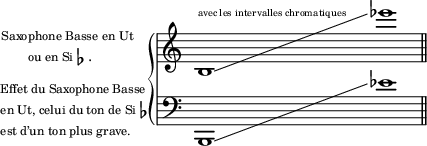Grand Traité d’instrumentation et d’orchestration modernes/Les Saxophones
Henry Lemoine & Cie (p. 284-285).
LES SAXOPHONES
sont au nombre de Six :
L’Aigu, le Soprano, le Contralto, le Ténor, le Baryton et la Basse.
Mr SAX en produira même prochainement un septième : le Saxophone Contrebasse.
L’étendue de chacun d’eux est à peu près la même et voici leur gamme écrite pour tous sur la clef de Sol, comme celle des clarinettes, d’après le système proposé par Mr Sax et déjà adopté par les compositeurs.






Les trilles majeurs et mineurs sont praticables sur presque toute l’étendue de l’échelle chromatique des Saxophones. Voici ceux qu’il convient d’éviter :

Mr SAX a encore produit les familles des Sax horns, des Saxotrombas et des Saxtubas, instruments en cuivre à bocal (embouchure évasée) avec un mécanisme de trois, quatre, ou cinq cylindres.
